
The next stop: Transit tops priority lists as cities look beyond pandemic
By David Kennedy
Infrastructure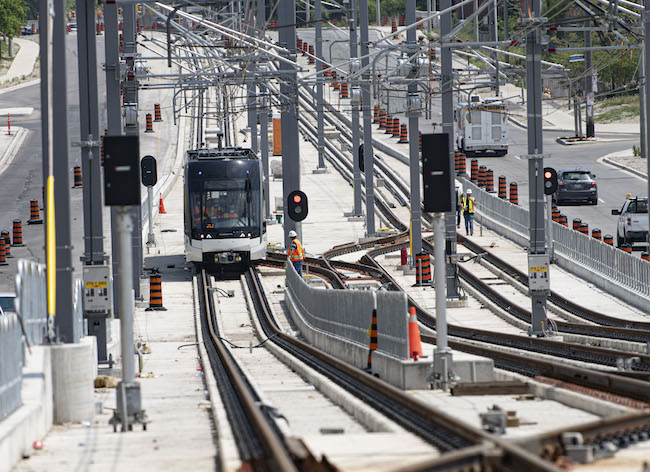
Eglinton Crosstown light rail vehicle testing in Toronto. The new midtown line is scheduled to open next year. PHOTO: Metrolinx
Pick a Canadian city approaching or over a million inhabitants, and you will find a billion-dollar transit project, often more than one.
Work on new hospitals, and more traditional infrastructure such as roads and bridges, is not letting up, but subway, light rail and even conventional rail lines have clawed their way up urban agendas despite competing budget priorities and more recently, dismal pandemic-induced ridership. With more than two dozen new or extended systems in the works coast to coast, the future of Canadian cities — and no small portion of their contractors’ fortunes — is on these lines.
MARCHING ORDERS FROM QUEEN’S PARK
Canada’s most populous province is, unsurprisingly, home to the largest tally of transit projects in the country, and the list is only growing longer.
It has been a decade since early work began on the 25-stop Eglinton Crosstown that will run across midtown Toronto. Delays have pushed back the timeline, but construction on the new light rail line is scheduled to be complete by 2022. Nearby, on the opposite side of Hwy. 401, construction is also well underway on the $2.5 billion Finch West LRT. The project’s 11 kilometres of rail are expected to open in 2023.
In Toronto’s two largest suburbs, Metrolinx is overseeing construction of the Hurontario LRT as well. With 18 km of rail and 19 stops, the new $4.6 billion line will carve out dedicated rapid transit space on the busy route through Mississauga and Brampton.
Farther west, trains recently began running on Grand River Transit’s Ion light rail network through Kitchener and Waterloo. Service launched in 2019, but the transit operator for the region is already mapping out a second stage for the 19-km line that will extend the rails southeast into Cambridge.
For Metrolinx, a Crown corporation responsible for transit in the Greater Toronto and Hamilton Area (GTHA), the list of projects to juggle will only get more complicated as the 2020s wear on. The province set work in motion on four “priority” transit projects in 2019 that will stretch Toronto’s transit system north, west and east.
The marquee component of the Queen’s Park plan, the Ontario Line, will run through Toronto’s downtown, before swinging through East York, and then north to meet up with the Eglinton Crosstown. Running through dense neighbourhoods, it will require a considerable amount of underground construction. Metrolinx and government procurement specialist Infrastructure Ontario (IO) have broken the megaproject into three P3 contracts. Cost estimates total $10.9 billion. Major construction could start as early as 2023.
Tunnelling contracts for the long-awaited Scarborough Subway Extension and the Eglinton Crosstown West LRT were handed down this spring, kicking off two other aspects of the four-part plan. Underground crews are scheduled to have tunnel boring machines in the ground for both projects next year. Procurement and construction for station work will follow later this decade. Combined, the two extensions are expected to cost about $10 billion.
The final priority project, the Yonge North Subway Extension remains in pre-procurement, but an RFQ for the estimated $5 billion job is expected this fall. With Toronto’s existing Yonge subway line crowded even before four stops are tacked onto its north end, the extension is scheduled to open after the Ontario Line, which is designed to relieve some of the pressure. A $1.5 billion retrofit is also planned for Yonge-Bloor Station, another bottleneck and the busiest subway station in the city.
Rounding out the considerable roster of Toronto-centric projects, the Sheppard East subway extension has entered the early planning stages, but remains years away.
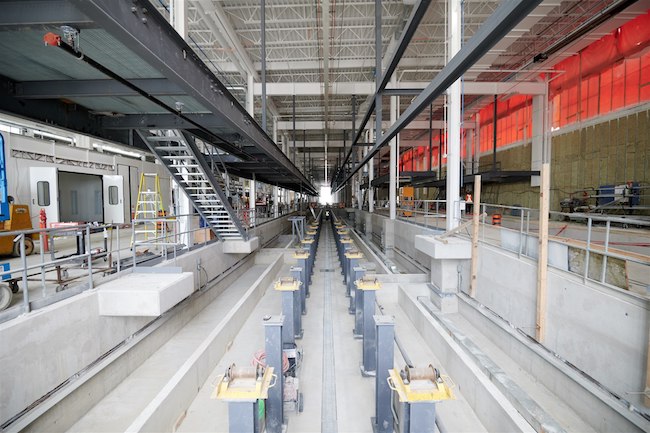
The Interior of the new Finch West Maintenance and Storage Facility that will support the LRT project. PHOTO: Metrolinx
At the westernmost tip of Lake Ontario, after being abruptly cancelled at the end of 2019, the Hamilton LRT is back on the docket as well. An agreement between the Ontario and federal governments resurrected the 17-stop project this May. Uncertainties remain, but construction on the line, worth $3.4 billion in its latest incarnation, could start next year.
Meanwhile, the years-long initiative to transition GO Transit from a commuter rail service to a fully-fledged regional rail network with all-day, two-way service is scheduled to begin in earnest next year. In addition to ongoing station upgrades, IO expects to begin execution of a mammoth contract that includes a flurry of rail corridor upgrades worth well over $10 billion in 2022.
Not to be outdone, transit activity in Ontario’s other big population centre has picked up considerably in recent years. After significant delays, Ottawa’s new Confederation Line opened in late 2019. But even before light rail vehicles began carrying passengers, the city had handed out contracts for two extensions, cumulatively known as Stage 2.
The first of these projects will extend and upgrade the older Trillium Line, adding four new stations at its south end and an airport spur. Two stations will also be integrated into the existing portion of the line, which has been closed since May 2020 to accommodate the project. Contractors are scheduled to complete the $1.6 billion job by 2022.
The Confederation Line, which runs parallel to the Ottawa River, will see extensions on both its east and west ends. The eastern extension will allow O-Trains to run all the way to Trim Road. Those 12 km of new rail and five stations are expected to open by 2024. On the west end of the Canadian capital, crews are tasked with the final part of Stage 2, which includes building 11 new stations over 15 km. That extension, beyond Tunney’s Pasture, is scheduled to open by 2025. The price tag for the work on both ends of the Confederation Line totals approximately $2.6 billion.
MIXING PRIVATE AND PUBLIC IN QUEBEC
The Réseau express métropolitain (REM), now three years into construction in Montreal, will keep crews at more than two-dozen sites throughout the city busy through 2024. The largest transit project currently underway in the province, the 26-station light rail network, backed by Caisse de dépôt et placement du Québec, will span 67 km. The pandemic and other issues during construction have pushed the cost of the system to $6.9 billion, up from $6.3 billion originally. That figure is certain to rise further due to problems crews encountered in the Mont Royal Tunnel. However, the cost of bringing the century-old tunnel up to code has not yet been determined. Scheduled to open in stages, segments of the line are currently between three and 18 months behind their original timelines.
As 3,000 workers toil on the original REM, the network’s pension fund backer is already working on expanding it to the east. Last December, officials from the Caisse and the Quebec government unveiled plans for the REM de l’Est. The proposed extension will add 23 additional stations across 32 km of both elevated and underground segments. Planning for the expansion is in the relatively early stages, with cost estimates topping $10 billion.
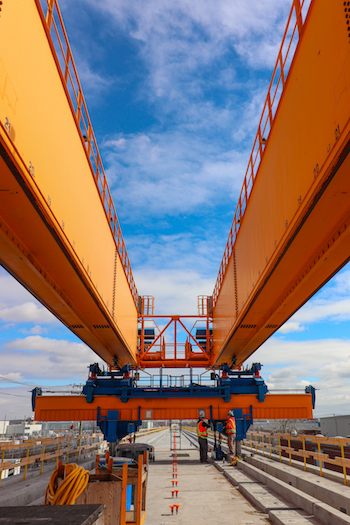
A launching gantry known as Marie in-use on the REM project in Montreal. PHOTO: REM/NouvLR
The wheels are also in motion for a five-stop extension to the Montreal metro’s Blue Line. The on-again, off-again project has been contemplated for more than 40 years, but federal backing announced in 2019 pushed the five-stop extension to the top of priority lists. The Société de transport de Montréal began consultations for the 5.8 km of added tunnel last year and has started prep work. With planning ongoing, however, the original timeline for the start of major construction this year and the 2026 completion date appear in doubt. Early estimates put the cost of the extension at $4.5 billion.
Meanwhile, in Quebec City, planning is underway for a new light rail line running 19 km through downtown. Initially expected to open in 2027, Le Tramway de Québec hit an early snag due to train maker Alstom’s purchase of Bombardier Transportation this winter, forcing it to relaunch procurement to keep the process competitive. Construction is now scheduled to start on the 28-station line in 2023. Costs are estimated at $3.4 billion
Even earlier in the planning process, a light rail line is also being studied in Gatineau. The proposed line would link up with the O-Train across the river in Ottawa.
LRTS LINING UP IN ALBERTA
Light rail vehicles have been running in Edmonton since the late ‘70s, but the past decade has spawned a handful of new plans that will extend two existing lines and add another.
Separated into two phases to simplify delivery, the initial segment of the new 27-km Valley Line is nearing completion and crews are readying their shovels for the second. The P3 consortium behind the $1.8 Southeast portion of the Valley Line started construction in 2016 and is scheduled to hand over the line by the end of this year. This sets the stage for the second phase, for which the city awarded a $2.6 billion contract last fall. Work will get underway on the Valley Line West this year and light rail vehicles are expected to begin running in five or six years.
In the meantime, an extension of Edmonton’s existing Metro Line started in 2020. The first step in the Metro Line Northwest project, crews are building two new permanent stations and about 1.6 km of track. Two subsequent phases are in planning and design, which will eventually stretch the LRT line seven more stops to the northwest.
The design has also been mapped out for an extension of the Capital Line at the southern end of Edmonton. The city again plans to break the project into separate phases. The preliminary design for a 4.5-km first stage, which will extend the line from Century Park to Ellerslie Road, has been completed. With city and provincial backing, the project is just awaiting a nod on funding from Ottawa.

A rendering of Sheppard Station on Calgary’s Green Line. PHOTO: City of Calgary
Transit expansion has climbed priority lists in Calgary in recent years as well, though the process to get shovels in the ground for the Green Line LRT has been relatively rocky. City council signed off on the big-ticket project last June, but a provincial review of city plans put the 15-station light rail project on hold, and funds from both Alberta and Ottawa were only reconfirmed last month. The $5.5 billion project will run from 126 Avenue Southeast to 16 Avenue North, crossing over the Bow River and ducking underground through the city’s downtown. Initially laid out in three stages, the reconfigured plan includes just two. Following the delay to procurement, major construction is unlikely to start on the Green Line before next year, though early work is scheduled for this fall.
EXTENSIONS ON THE WEST COAST
Demolition crews began clearing the way this winter for construction of a six-stop extension of Vancouver’s Millennium Line. The $2.8 billion Broadway Subway project will add a half dozen subterranean stations and extend the western end of the SkyTrain line underground by five km. A 700-metre elevated guideway from VCC–Clark Station is also included. Construction on the guideway and tunnel portals started this spring. A pair of boring machines, which will dig twin 6.3-m diameter tunnels, are set to launch next year. The build team is working toward a 2025 completion date.
Work along Broadway is one of several extensions to the SkyTrain currently underway.
Just last month, Prime Minister Justin Trudeau was in Surrey to announce federal funding for an extension to another of Metro Vancouver’s three SkyTrain lines. The Surrey Langley SkyTrain will add eight stations to the existing Expo Line, extending the system 16 km to the southeast from its current terminus just south of central Surrey. A 2019 cost estimate pegged the project at $3.1 billion, but federal funding commitments indicate the price tag has likely risen to $3.8 billion. The extension replaces an aborted light rail project quashed by Surrey City Council in favour of the higher capacity SkyTrain in 2018. Early construction could get underway shortly, but regional transit agency TransLink says lining up a build team is likely to take 15 months. Four years of construction will follow.
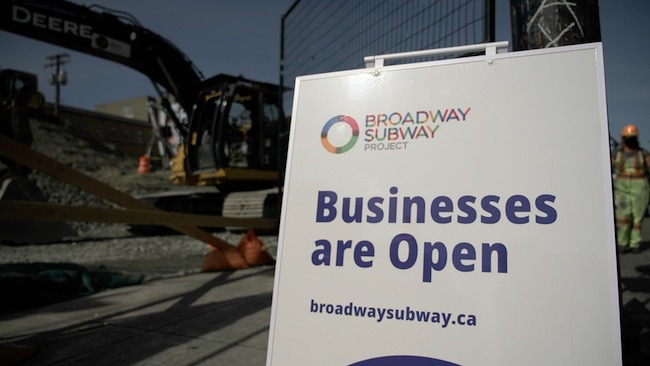
Construction on the initial components of the Broadway subway project started this spring. PHOTO: Province of B.C.
On the heels of the Broadway Subway project, a further extension of the SkyTrain’s Millennium Line is also under review. That project, estimated at over $3 billion, would pick up where the current extension leaves off, stretching the line farther west to the University of British Columbia campus.
A less conventional project to give students a lift to Simon Fraser University’s campus atop Burnaby Mountain is also being studied. TransLink is deep into its assessment of a proposed gondola project that would run from one of three nearby SkyTrain stations, up the steep route to the forested peak, carrying up to 25,000 passengers per day.
INTERCITY REVIVAL
Complementing urban transit upgrades, several prominent projects to build better rail links between cities Canadians often opt to fly between are garnering interest.
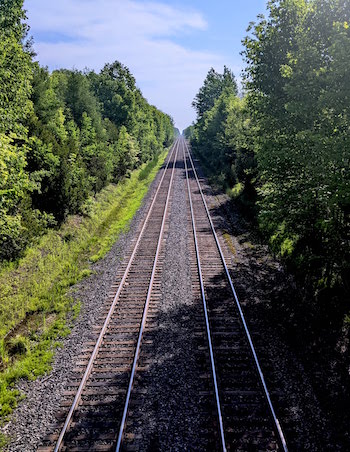
Passenger trains running between Toronto, Ottawa, Montreal and Quebec City today typically share rail space with freight traffic. PHOTO: David Kennedy
Last month, the federal government inched forward on a long-debated high-frequency passenger rail line that would connect Toronto, Ottawa, Montreal and Quebec City. Via Rail has long served all destinations, but delays are commonplace, partly due to the passenger trains running primarily on track owned by freight companies. Early studies for the project to build a dedicated line began in 2016, and with the July announcement, stakeholder engagement will now get underway. Early estimates for the project range from $6 billion to $12 billion.
In Alberta, a high-speed connection between Calgary and Edmonton has been bandied about for years. In 2008, for instance, a pair of studies assessed a possible high-speed rail line, and the environmental benefits of such a project have only grown more consequential in the interim. The Alberta Ministry of Transportation is currently working with two separate groups, one of which has proposed building a hyperloop between the two cities; the other, revealed just last month, aims to build a conventional high-speed rail line at an estimated cost of $9 billion. Both projects remain at the early planning stages.
A passenger rail line between Calgary and the mountainous tourist town of Banff is under review as well. The Canada Infrastructure Bank and Invest Alberta Corp. are in the early stages of assessing the project, which would include seven stops along the roughly 150-km route.
Another proposal would make Vancouver the end of a West Coast high-speed line. Though no commitments have been made, a high-speed rail line connecting the largest cities in what’s known as the Cascadia region could eventually tie together Vancouver, Seattle and Portland at a cost of between US$24 billion and $42 billion.
GOING OFF-TRACK
Dedicated bus rapid transit (BRT) is becoming increasingly common across Canada, typically in cities or neighbourhoods with population densities unable to support higher-capacity LRTs. Winnipeg, for instance, completed its first BRT line in 2012. The largest Canadian city that relies entirely on buses for local transportation plans to stick to them for the foreseeable future. This April, city council approved a plan that would reorient Winnipeg’s existing bus network to feed three BRT lines. Costs for implementing the 25-year master plan could run to $1.1 billion.
This article first appeared in the August 2021 edition of On-Site. Click here to read through the full issue.




